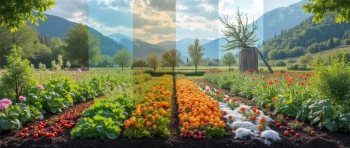Utah's diverse climate zones and unique growing conditions create both challenges and opportunities for home gardeners. From the high mountain valleys to the warm desert regions, knowing what to plant and when can make the difference between a bountiful harvest and disappointment. This comprehensive guide breaks down Utah gardening by season, helping you make the most of your garden year-round.
Understanding Utah's Growing Conditions
Before diving into seasonal planting guides, it's important to understand some key factors that influence gardening success in Utah:
Climate Zones
Utah spans USDA hardiness zones 4-9, with most populated areas falling within zones 5-7:
- Zone 4: High mountain areas (Park City, parts of Cache Valley)
- Zone 5: Northern valleys (Salt Lake City, Ogden, most of Utah County)
- Zone 6: Central and transitional areas (parts of Utah County, Cedar City)
- Zone 7-9: Southern regions (St. George, Moab)
Utah's Gardening Challenges
- Short growing season: Many areas have frost-free periods of only 120-180 days
- Alkaline soil: Utah soils typically have high pH (7.5-8.5)
- Low humidity: Increases water needs and affects some plants
- High elevation: Intense sunlight and temperature fluctuations
- Water scarcity: Conservation is essential
Spring Gardening in Utah (March-May)
Spring in Utah is a time of unpredictable weather, with potential for late frosts even as temperatures begin to warm. Strategic planning is essential.
Early Spring (March-April)
Vegetables to Plant
Direct Sow Outdoors:
- Peas (early March)
- Spinach
- Lettuce
- Radishes
- Carrots
- Kale
- Swiss chard
Start Indoors:
- Tomatoes (8 weeks before last frost)
- Peppers (8-10 weeks before last frost)
- Eggplant
- Broccoli
- Cabbage
- Cauliflower
Fruits to Plant
- Bare root fruit trees (apples, pears, peaches)
- Bare root berries (raspberries, strawberries)
- Grape vines
Landscaping Tasks
- Clean up winter debris
- Prune summer-flowering shrubs
- Apply pre-emergent weed control
- Divide perennials
- Plant trees and shrubs before heat arrives
Late Spring (May)
Vegetables to Plant
Direct Sow Outdoors:
- Beans (after last frost)
- Corn
- Cucumbers
- Summer squash
- Pumpkins
- Watermelon (southern Utah)
Transplant Outdoors:
- Tomatoes (after danger of frost)
- Peppers
- Eggplant
Fruits to Care For
- Thin fruit tree blossoms (leave 4-6 inches between fruits)
- Apply organic mulch around berries
- Install bird netting as needed
Landscaping
- Plant warm-season annual flowers
- Reseed bare lawn patches
- Plant drought-tolerant perennials
Summer Gardening in Utah (June-August)
Summer brings intense heat and dry conditions that require careful water management and heat-tolerant plantings.
Early Summer (June)
Vegetables to Plant
- Beans (succession planting)
- Summer squash (succession planting)
- Heat-tolerant lettuces
- Herbs (basil, cilantro, dill)
Fruits to Care For
- Continue fruit thinning
- Support heavy fruit branches
- Deep water fruit trees weekly
Landscaping Tasks
- Deadhead flowering plants
- Apply mulch to conserve moisture
- Prepare fall flower beds
Mid-Late Summer (July-August)
Vegetables to Plant
- Fall crops of spinach (in partial shade)
- Fall lettuces (in partial shade)
- Kale for fall harvest
- Carrots for fall harvest
- Beets
Fruits to Care For
- Harvest early varieties
- Monitor irrigation closely
- Protect from sunscald with shade cloth if needed
Landscaping Tasks
- Deep water trees and shrubs in early morning
- Watch for heat stress and adjust watering
- Plan for fall planting
Fall Gardening in Utah (September-November)
Fall offers ideal growing conditions for many crops and is the best time for establishing perennials and trees.
Early Fall (September-October)
Vegetables to Plant
- Garlic (for next year's harvest)
- Cover crops in empty beds
- Cold frames with lettuce and spinach
Fruits to Plant
- New strawberry plants
- Fall-bearing raspberries
- Fruit trees (best time for establishment)
Landscaping Tasks
- Plant trees and shrubs
- Divide and transplant perennials
- Reseed lawn areas
- Plant spring-flowering bulbs
Late Fall (November)
Garden Preparation
- Clean up vegetable beds
- Apply compost to garden beds
- Mulch perennials after ground freezes
Fruit Tree Care
- Wrap young tree trunks to prevent winter damage
- Apply dormant oil spray after leaf drop
- Fall pruning of established trees
Landscaping Tasks
- Protect sensitive plants
- Final lawn mowing
- Winterize irrigation systems
Winter Gardening in Utah (December-February)
While outdoor growing is limited, winter is an excellent time for planning and indoor gardening projects.
Indoor Gardening
- Grow herbs on sunny windowsills
- Force bulbs for winter color
- Start microgreens and sprouts
- Plan next year's garden
Garden Planning
- Order seeds and plants
- Test and amend soil
- Repair tools and equipment
- Design new garden beds
Winter Protection
- Maintain winter mulch
- Protect plants from heavy snow load
- Monitor for rodent damage on fruit trees
Best Fruits for Utah Gardens
Utah's climate is excellent for many fruits, particularly with proper variety selection.
Tree Fruits
- Apples: 'Honeycrisp', 'Gala', 'Jonathan'
- Peaches: 'Elberta', 'Redhaven', 'Reliance'
- Cherries: 'Bing', 'Montmorency' (sour), 'Utah Giant'
- Apricots: 'Chinese', 'Moorpark', 'Tilton'
- Pears: 'Bartlett', 'D'Anjou', 'Kieffer'
- Plums: 'Italian Prune', 'Santa Rosa', 'Mount Royal'
Small Fruits
- Grapes: 'Concord', 'Himrod', 'Canadice'
- Raspberries: 'Caroline', 'Autumn Bliss', 'Boyne'
- Strawberries: 'Chandler', 'Seascape', 'Tribute'
- Blackberries: 'Triple Crown', 'Chester' (need winter protection)
Best Vegetables for Utah Gardens
Cool Season Vegetables
- Broccoli
- Cabbage
- Carrots
- Lettuce
- Onions
- Peas
- Potatoes
- Radishes
- Spinach
Warm Season Vegetables
- Tomatoes
- Peppers
- Corn
- Beans
- Cucumbers
- Melons (in warmer areas)
- Squash
- Pumpkins
Utah Native Plants for Low-Maintenance Landscaping
Incorporating native plants helps create sustainable landscapes that thrive with minimal inputs.
Native Trees and Shrubs
- Gambel Oak
- Utah Serviceberry
- Bigtooth Maple
- Four-wing Saltbush
- Oakleaf Sumac
- Mountain Mahogany
Native Perennials
- Utah Penstemon
- Sulfur Buckwheat
- Showy Milkweed
- Firecracker Penstemon
- Blue Flax
- Blanketflower
Native Groundcovers
- Kinnikinnick
- Utah Sweetvetch
- Prairie Smoke
- Creeping Oregon Grape
Water-Wise Gardening Tips for Utah
Water conservation is essential in Utah's arid climate. These strategies help maximize garden production while minimizing water use:
Irrigation Strategies
- Install drip irrigation for vegetables and fruits
- Group plants with similar water needs
- Water deeply and infrequently
- Use smart controllers that adjust for weather
- Water in early morning to reduce evaporation
Soil Improvements
- Add organic matter to improve water retention
- Use compost to improve soil structure
- Apply mulch to reduce evaporation
- Consider hugelkultur beds for water-efficient growing
Design Considerations
- Create windbreaks to reduce evaporation
- Use swales to capture natural rainfall
- Install rainwater harvesting systems
- Consider raised beds for better drainage control
Conclusion
Successful gardening in Utah requires understanding the unique climate challenges and opportunities of your specific location. By following seasonal planting guides and selecting appropriate varieties, you can enjoy a productive garden year-round. Focus on building healthy soil, conserving water, and incorporating native plants for a sustainable landscape that thrives in Utah's distinctive growing conditions.
Whether you're growing juicy tomatoes in summer, harvesting crisp apples in fall, or planning your garden during winter, this guide will help you make the most of each gardening season in the Beehive State.





